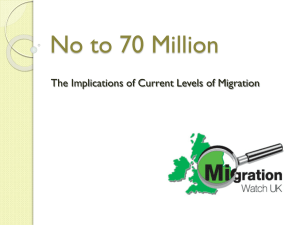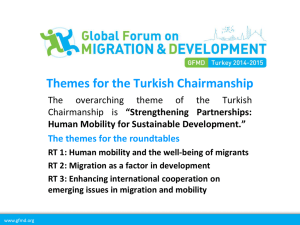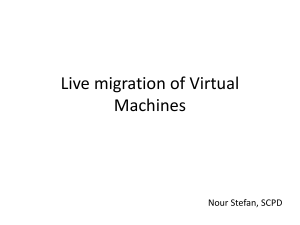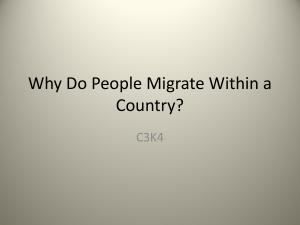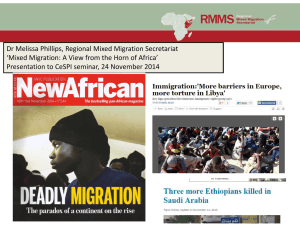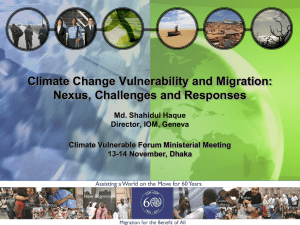Angela Santucci - International Organization for Migration
advertisement
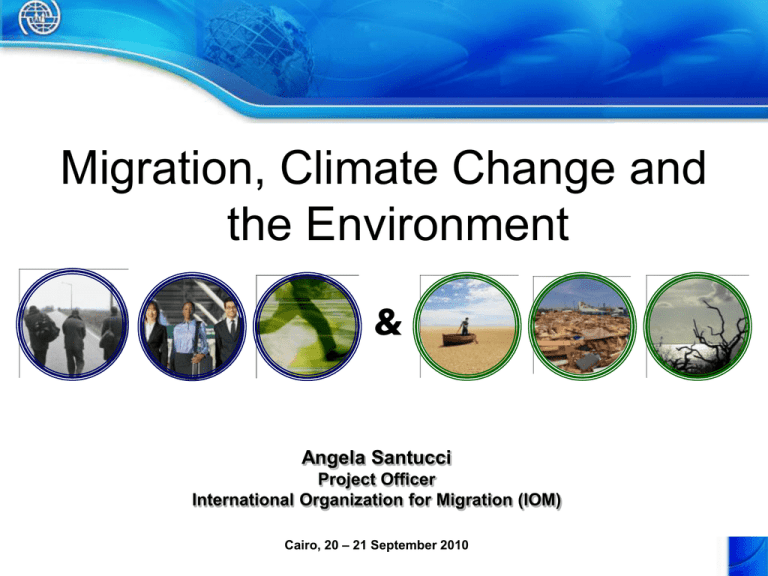
Migration, Climate Change and the Environment & Angela Santucci Project Officer International Organization for Migration (IOM) Cairo, 20 – 21 September 2010 Potential Effects of Climate Change “The gravest effects of climate change may be those on human migration.” Intergovernmental Panel on Climate Change (IPCC), 1990 • Where do we stand now? – 20 million displaced by climate related natural disasters in 2008 • What about the future? – Most widely cited figure: 200 million environmental migrants by 2050 Links Between Environment and Migration • Both natural disasters and environmental degradation can induce migration • Climate change is likely to exacerbate these events and processes • Migration can affect the environment in places of destination & origin and along transit routes • Economic, social and developmental factors complicate the interactions between migration and the environment • Environmental migration is a multi-causal phenomenon Migration as Adaptation • Migration can strengthen livelihoods through income diversification via remittances, the transfer of knowledge and skills and/or relocation • Migration is one possible adaptation strategy Case Study: Egypt • Expected climate change impacts: – Sea-level rise – Water scarcity – Desertification • Expected impacts on human mobility: – International mobility – Internal mobility (rural to urban) North Coast and Nile Delta • 60% of Egypt’s agriculture • Four million people • Vulnerable to sea rise and salination • Sediment starvation • Internal and international migration Egypt: Land at Risk from Sea-level Rise Egypt: Migration by Governorate International Migration Aspirations among Egyptian Youth 15-29, by Governorate Egypt: Migration by Governorate Internal Migration Experience among Egyptian Youth 18-29, by Destination Governorate Pilot Project: Assessment and Strategy Development to Respond to Sea-Level Rise and Human Mobility • To better understand actual and potential impacts and consequences of sea-level rise on human mobility – Creation of a technical working group of key stakeholders and inception workshop – Rapid assessments conducted • To design and test practical pilot initiatives to help respond to sea-level rise induced mobility – Pilot initiatives developed and implemented – Assessment of pilot initiatives to evaluate success • To enhance awareness among key stakeholders of the inter-linkages between sea-level rise and human mobility – Workshop for key stakeholders to disseminate findings and develop recommendations and follow up actions – Final report based on assessment findings and implemented activities, including lessons learned and recommendations Donor: IOM’s 1035 Funding Facility The Way Forwards: IOM’s Vision • First - minimize forced migration and ensure protection and assistance where displacement is inevitable; • Second - facilitate the role of migration as an adaptation strategy to climate change and seek to strengthen the developmental benefits of such migration for areas of origin; • Third - plan for relocation in areas that are expected to become uninhabitable to avoid a crisis situation and ensure sustainability; • Fourth - bolster humanitarian action with adequate resources to meet the growing challenge of climate change; • Fifth - mainstream environmental and climate change considerations into migration management policies and practice, and vice versa. Thank you




